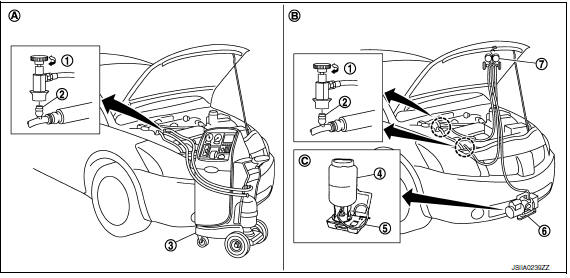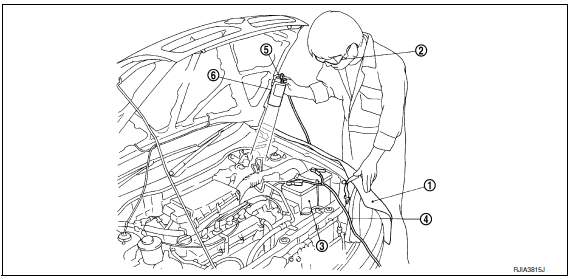Nissan Maxima Service and Repair Manual: Refrigerant
Description
CONNECTION OF SERVICE TOOLS AND EQUIPMENT

- Shut-off valve
- A/C service valve
- Recovery/recycling/recharging equipment
- Refrigerant container (HFC-134a)
- Weight scale (J-39650)
- Vacuum pump (J-39649)
- Manifold gauge set (J-39183)
- Preferred (best) method
- Alternative method
- For charging
Leak Test
CHECK REFRIGERANT LEAKAGE USING FLUORESCENT LEAK DETECTION DYE

- Install a fender cover (1).
- Wear UV safety goggles (2) provided with refrigerant dye leak detection kit (J-43926).
- Connect power cable (4) of UV lamp (6) to positive and negative terminals of the battery (3).
- Press UV lamp switch (5) and check A/C system for refrigerant leakage. (Where refrigerant leakage occurs, fluorescent leak detection dye appears in green color.)
WARNING: Do not look directly into UV lamp light source.
NOTE:
- For continuous operating time of UV lamp, follow the manufacturer operating instructions.
- Illuminate piping joints from different angles using UV lamp and check that there is no leakage.
- Use a mirror in area that is difficult to see to check refrigerant leakage.
- Refrigerant leakage from evaporator can be detected by soaking cotton swab or a similar material with drain hose water and illuminating it using UV lamp.
- Dust, dirt and packing materials adhesive used for condenser,
evaporator, and other locations may fluoresce.
Be careful not to misidentify leakage.
- Repair or replace parts where refrigerant leakage occurs and wipe off fluorescent leak detection dye. NOTE: Completely wipe off fluorescent leak detection dye from gaps between parts, screw threads, and others using a cotton swab or similar materials.
- Use a UV lamp to check that no fluorescent leak detection dye remains after finishing work.
WARNING: Do not look directly into UV lamp light source.
NOTE:
- For continuous operating time of UV lamp, follow the manufacturer operating instructions.
- Dust, dirt, and packing materials adhesive used for condenser,
evaporator, and other locations may fluoresce.
Be careful not to misidentify leakage.
CHECK REFRIGERANT LEAKAGE USING ELECTRICAL LEAK DETECTO
WARNING: Do not check refrigerant leakage while the engine is running.
CAUTION: Be careful of the following items so that inaccurate checks or misidentifications are avoided.
- Do not allow refrigerant vapor, shop chemical vapors, cigarette smoke or others around the vehicle.
- Always check refrigerant leakage in a low air flow environment so that refrigerant may not disperse when leakage occurs.
- Stop the engine.
- Connect recovery/recycling/recharging equipment or manifold gauge set (J-39183-C) to A/C service valve.
- Check that A/C refrigerant pressure is 345 kPa (3.52 kg/cm2, 50 psi) or more when temperature is 16C (61F) or more. When pressure is lower than the specified value, recycle refrigerant completely and fill refrigerant to the specified level. NOTE: Leakages may not be detected if A/C refrigerant pressure is 345 kPa (3.52 kg/cm2, 50 psi) or less when temperature is less than 16C (61F).
- Clean area where refrigerant leakage check is performed and check refrigerant leakage along all surfaces of pipe connections and A/C system components using electrical leak detector (J-41995) probe.
CAUTION:
- Continue checking when a leakage is found. Always continue and complete checking along all pipe connections and A/C system components for additional leakage.
- When a leakage is detected, clean leakage area using compressed air and check again.
- When checking leakage of cooling unit inside, always clean inside of drain hose so that the probe surface may not be exposed to water or dirt.
NOTE:
- Always check leakage starting from high-pressure side and continue to low-pressure side.
- When checking leakage of cooling unit inside, operate blower fan motor for 15 minutes or more at the maximum fan speed while the engine is stopped, and then insert electrical leak detector probe into drain hose and hold for 10 minutes or more.
- When disconnecting shut-off valve that is connected to A/C service valve, always evacuate remaining refrigerant so that misidentification can be avoided.
- Repair or replace parts where refrigerant leakage is detected. (Leakage is detected but leakage area is unknown.)
- Start the engine and set A/C control in the following conditions.
- A/C switch ON
- Air flow: VENT (ventilation)
- Intake door position: Recirculation
- Temperature setting: Full cold
- Fan (blower) speed: Maximum speed set
- Run the engine at approximately 1,500 rpm for 2 minutes or more.
- Stop the engine. Check again for refrigerant leakage. Go to step 4.
WARNING: Be careful not to get burned when the engine is hot.
NOTE:
- Start refrigerant leakage check immediately after the engine is stopped.
- When refrigerant circulation is stopped, pressure on the lowpressure side rises gradually, and after this, pressure on the high-pressure side falls gradually.
- The higher the pressure is, the easier it is to find the refrigerant leakage.

Recycle Refrigerant
WARNING:
- Always use HFC-134a for A/C refrigerant. If CFC-12 is accidentally charged, compressor is damaged due to insufficient lubrication.
- Always observe and follow precautions described on refrigerant container. Incorrect handling may result in an explosion of refrigerant container, frostbite or the loss of eyesight.
- Do not breathe A/C refrigerant and oil vapor or mist. Exposure may irritate eyes, nose, or throat.
- Do not allow HFC-134a to be exposed to an open flame or others because it generates poisonous gas when in contact with high temperature objects. Keep workshop well ventilated.
- Perform oil return operation. Refer to HA-30, "Perform Oil Return Operation". (If refrigerant or oil leakage is detected in a large amount, omit this step, and go to step 2.) CAUTION: Do not perform oil return operation if a large amount of refrigerant or oil leakage is detected.
- Check gauge pressure readings of recovery/recycling/recharging equipment. When remaining pressure exists, recycle refrigerant from high-pressure hose and low-pressure hose. NOTE: Follow manufacturer instructions for the handling or maintenance of the equipment. Do not fill the equipment with non-specified refrigerant.
- Remove A/C service valve cap from the vehicle.
- Connect recovery/recycling/recharging equipment to A/C service valve.
- Operate recovery/recycling/recharging equipment, and recycle refrigerant from the vehicle.
- Evacuate air for 10 minutes or more to remove any remaining refrigerant integrated to compressor oil, etc.
- Refrigerant recycle operation is complete.
Charge Refrigerant
WARNING:
- Always use HFC-134a for A/C refrigerant. If CFC-12 is accidentally charged, compressor is damaged due to insufficient lubrication.
- Always observe and follow precautions described on refrigerant container. Incorrect handling may result in an explosion of refrigerant container, frostbite, or the loss of eyesight.
- Do not breathe A/C refrigerant and oil vapor or mist. Exposure my irritate eyes, nose, or throat.
- Do not allow HFC-134a to be exposed to an open flame or others because it generates poisonous gas when in contact with high temperature objects. Keep workshop well ventilated.
- Connect recovery/recycling/recharging equipment to the A/C service valve.
- Operate recovery/recycling/recharging equipment, and evacuate air from A/C system for 25 minutes or more. CAUTION: Evacuate air for 15 minutes or more if the parts are replaced.
- Check the airtightness of A/C system for 25 minutes or more. If
pressure raises more than the specified level, charge A/C system with
approximately 200g refrigerant and check that there is no refrigerant
leakage.
Refer to HA-26, "Leak Test". CAUTION: Check the airtightness for 15 minutes or more if the parts are replaced.
- If parts other than compressor are replaced, fill compressor oil according to parts that are replaced.
- Charge the specified amount of refrigerant to A/C system.
- Check that A/C system operates normally.
- Disconnect recovery/recycling/recharging equipment. (Collect the refrigerant from the high-pressure hose and low-pressure hose of recovery/recycling/recharging equipment.)
- Install A/C service valve cap.
- Refrigerant charge is complete.
 Oil
Oil
Description
MAINTENANCE OF OIL LEVEL
The compressor oil is circulating in the system together with the
refrigerant. It is necessary to fill compressor with oil when replacing A/C
system parts or ...
Other materials:
Brake booster
Exploded View
Master cylinder assembly
Brake booster
Brake pedal
Lock nut
Gasket
Removal and installation
NOTE:
When removing components such as hoses, tubes/lines, etc., cap or plug openings
to prevent fluid from spilling.
REMOVAL
Release the fuel pressure. Refer to ...
P0128 thermostat function
DTC Logic
DTC DETECTION LOGIC
NOTE:
If DTC P0128 is displayed with DTC P0300, P0301, P0302, P0303, P0304, P0305 or
P0306, first perform
the trouble diagnosis for DTC P0300, P0301, P0302, P0303, P0304, P0305, P0306.
Engine coolant temperature has not risen enough to open the thermostat even ...
Inside the vehicle
The maintenance items listed here should be
checked on a regular basis, such as when performing
scheduled maintenance, cleaning the vehicle,
etc.
Accelerator pedal: Check the pedal for smooth
operation and make sure the pedal does not
catch or require uneven effort. Keep the floor mat
away ...
Nissan Maxima Owners Manual
- Illustrated table of contents
- Safety-Seats, seat belts and supplemental restraint system
- Instruments and controls
- Pre-driving checks and adjustments
- Monitor, climate, audio, phone and voice recognition systems
- Starting and driving
- In case of emergency
- Appearance and care
- Do-it-yourself
- Maintenance and schedules
- Technical and consumer information
Nissan Maxima Service and Repair Manual
0.0083

